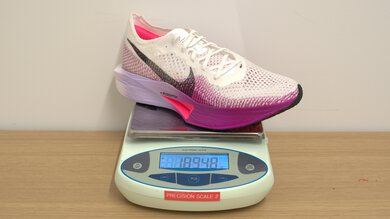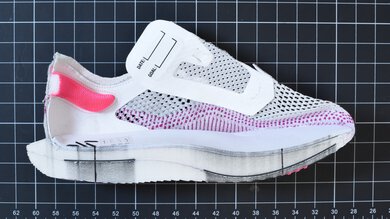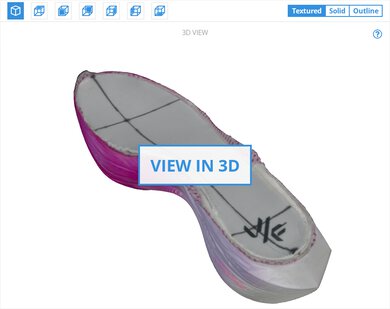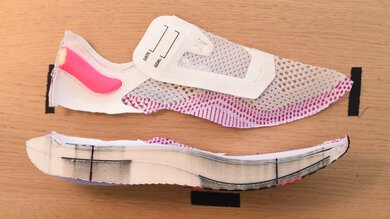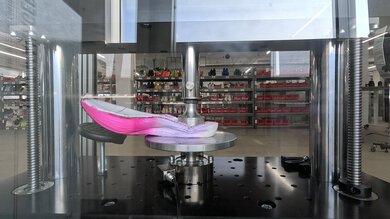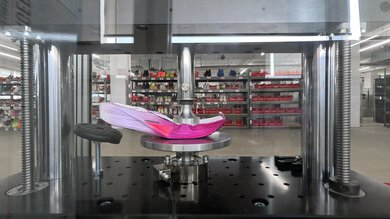The Nike Vaporfly 3 brings a fresh update to one of Nike's most iconic running shoes, designed specifically for competitive road racing. The shoe's construction incorporates lightweight cushioning and a full-length carbon fiber plate. It's lighter than its big brother, the Nike Alphafly 3, though it lacks some of the same cushioning. The Vaporfly 3's road-focused design and performance-oriented features make it appealing to runners seeking a snappy companion for race day or intense workout sessions.
Our Verdict
The Nike Vaporfly 3 is impressive for marathon racing, with a very lightweight design, excellent energy return, and a carbon fiber plate. However, what prevents it from being truly exceptional for this distance is its lack of lateral stability and cushioning, both of which become crucial in the later stages of a marathon when form starts to break down.
Very lightweight.
Snappy ride.
Not the most stable.
The Nike Vaporfly 3 is excellent for 5K/10K racing, primarily due to its firm forefoot foam, lightweight design, and carbon-fiber plate, which all contribute to a snappy and agile running experience. This combination of features makes the shoe particularly well-suited for shorter, faster races where speed and efficiency are paramount.
Very lightweight.
Very firm at the forefoot.
Snappy ride.
The Nike Vaporfly 3 offers impressive energy return, which contributes to a more efficient running stride. This energy return is facilitated by the midsole's ZoomX foam, which absorbs impact and rebounds effectively, allowing runners to maintain their pace over longer distances.
Snappy ride.
The cushioning in the Nike Vaporfly 3 is not bad, offering acceptable underfoot protection while keeping weight to a minimum. The heel provides passable cushioning, but the forefoot feels a bit less substantial. While this helps shave off some grams, runners seeking a more cushioned feel, especially in the forefoot, may find it lacking, particularly for longer efforts.
Heel cushioning is decent.
Forefoot lacks protection.
The Nike Vaporfly 3 offers satisfactory lateral stability, but its platform is quite narrow, which can make balance more challenging. With a lightweight design focused on performance, it sacrifices some side-to-side stability, which may be a drawback for runners needing extra help to maintain good form. However, for those prioritizing speed over shorter distances, the trade-off might be acceptable.
Very firm at the forefoot.
Very narrow base.
Lockdown suffers due to the non-gusseted tongue.
Performance Usages
Changelog
-
Updated Oct 20, 2025:
We've adjusted this review's writing to align with the new test bench, including updates to all usage scores, and test boxes for Cushioning, Firmness, and Energy Return. We've updated the side-by-side comparisons with other shoes accordingly.
- Updated Oct 20, 2025: We've converted this review to Test Bench 0.8.2, which updates our methodology for the impact force range used in our compression tests to improve their accuracy. This also affects all usage and performance usage boxes using those compression tests as score components.
-
Updated Jul 30, 2025:
We revised the phrasing in the Lateral Stability, Cushioning, Heel Cushioning, and Forefoot Cushioning boxes. We also updated the side-by-side comparisons with the Nike Alphafly 3, the Nike Zoom Fly 6, and the adidas Adizero Adios Pro 3 to better align with the latest test bench scores.
- Updated Jul 30, 2025: We've converted this review to Test Bench 0.8.1, which mainly updates the score components for the Marathon Racing and Lateral Stability usage boxes to improve accuracy.
Check Price
Differences Between Sizes And Variants
We tested the Nike Vaporfly 3 in men's US size 9, as noted on the label. The color shown here is White/Vivid Purple/Purple Agate/Black. This model is also offered in other colorways, including White/Particle Grey/Metallic Silver/Dark Smoke Grey, Volt/Scream Green/Barely Volt/Black, and Luminous Green/Crimson Tint/Volt/Black. Special editions include an Electric edition and an "Eliud Kipchoge" edition, adding unique style options.
Wide versions are not available for this model.
Popular Running Shoe Comparisons
The Nike Vaporfly 3 is made to go fast. Whether it's racing, hard interval sessions on the track, or time trials, this shoe thrives in all things speed-related. While it can handle longer races, it truly excels in the 5K and 10K, where its lightweight build, stiffness, and aggressive energy return shine. Compared to marathon-focused models like the Nike Alphafly 3, this shoe is less cushioned and less stable, but this is also what makes it one of the best options for shorter events where speed is the priority.
The Nike Vaporfly 4 is the latest in the series, offering a noticeably lighter and lower-stacked design that performs best from 5K up to the half marathon. If you need a super shoe but require extra stability, the Saucony Endorphin Pro 4 is perhaps a better choice. If you need a more versatile option that can handle a wider variety of workouts, check out the Nike Zoom Fly 6, a carbon-plated super trainer built for both speed sessions and steady mileage. For a reliable daily workhorse, Nike offers several strong options, including the Nike Invincible 3, which provides a highly energetic ride for its category, or the Nike Pegasus 41, a firmer option that offers more stability than the Vaporfly.
For more options, check out our recommendations for the best running shoes.
The Nike Vaporfly 3 and the Nike Alphafly 3 are two premium racing shoes, each catering to different types of runners and race distances, and your choice will depend on your priorities. The Vaporfly 3 is lighter and more agile and provides a firmer ride, making it a strong choice for shorter-distance races up to the half-marathon. It also has a lower stack height. However, the Alphafly 3 has somewhat better lateral stability, making it better suited for marathon racing. It's more cushioned, which can help absorb impact, especially in the later miles of a race. While the Vaporfly 3 is more snappy for shorter distances, the Alphafly 3 is designed to optimize efficiency over 26.2 miles, making it the preferred option for marathon specialists.
The Nike Vaporfly 4 and the Nike Vaporfly 3 are both elite-level racing shoes, but they deliver noticeably different experiences. The Vaporfly 4 is almost 30 grams lighter, features a somewhat softer, more cushioned midsole, and offers a slightly more accommodating fit, making it better suited for longer efforts, particularly the half marathon. In contrast, the Vaporfly 3 delivers a snappier ride, making it a more aggressive option best suited for shorter distances.
The Nike Zoom Fly 6 and the Nike Vaporfly 3 both draw from the same performance playbook but serve very different roles in a runner's rotation. The Vaporfly 3 is a true racing shoe, designed to be as light, efficient, and propulsive as possible. It uses a full ZoomX midsole with an aggressive plate setup to deliver an explosive toe-off, ideal for shorter race events. It's lighter, softer underfoot, and much more energetic than the Zoom Fly 6—built purely for speed and race-day efficiency. The Zoom Fly 6, by contrast, is Nike's super trainer, a more durable and approachable alternative for interval training. While it shares some design DNA with the Vaporfly, it uses a thinner top layer of ZoomX over a firmer SR-02 foam, which dulls the responsiveness considerably. It's also heavier and doesn't offer the same bounce or snap. However, it's more forgiving, more stable, and built to last, making it a reasonable option for long runs, tempo sessions, or runners who want to get used to plated geometry without jumping into a full-on racer.
The Nike Vaporfly 3 and the Saucony Endorphin Pro 4 are both popular super shoes, but with different ride characteristics. The Endorphin Pro 4 offers better cushioning, especially as force increases, and is significantly more stable, thanks to its wider outsole. The Vaporfly 3 provides a bit more energy return, contributing to its propulsive feel, and is lighter, giving it a more streamlined, race-day-ready feel. The Vaporfly 3 has firmer forefoot foam, which adds to its snappy toe-off compared to the smoother, more controlled ride of the Endorphin Pro 4.
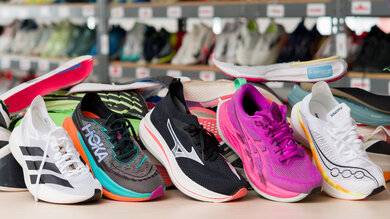
We've recently started buying and testing running shoes with a very data-oriented approach. While we're just getting started, our methodology already has dozens of tests to help you make the right purchasing decision for your needs. Not only do we use high-end equipment to gather objective data, but we also order multiple sizes of the same shoes for team members to be able to log in miles. This real-world testing is done at various paces and conditions, and with different types of workouts, to cover all the bases. This allows us to verify our results and ensure they align with what you might feel with a specific pair.
Test Results

Amazingly lightweight, this shoe keeps things minimal, shedding any unnecessary bulk to optimize performance. Its featherlight build enhances efficiency, making every stride feel effortless. Compared to other super shoes, the adidas Adizero Adios Pro Evo 1 is the outlier, being significantly lighter. However, the Nike still stand out as one of the lightest and most efficient racers available.
During testing, we noticed a discrepancy between the advertised and measured heel stack height. While the shoe was expected to have a 40 mm stack, our measurements consistently showed a slightly lower 37.2 mm. Even after stabilizing the shoe to eliminate variability, repeated tests yielded a maximum of 37.6 mm, confirming a 2-3 mm difference from the stated specifications.
During testing, we noticed that the insole length was shorter than expected. Based on industry standards, a size 9 performance shoe typically has an insole length of around 270 mm. However, repeated measurements confirmed that this model runs shorter than average. On foot, the fit feels noticeably tighter than other shoes in the same size, which isn't surprising since super shoes are typically designed with a snugger fit compared to daily trainers.
The Nike Vaporfly 3 delivers impressive heel energy return, ranking on par with the best super shoes on the market. The ZoomX foam effectively returns a lot of energy from each foot strike efficiently, providing a smooth and responsive ride.
The forefoot energy return in the Nike Vaporfly 3 is great, offering a springy and responsive toe-off. The combination of ZoomX foam and lightweight build creates a dynamic ride, making it easier to maintain speed. While it performs very well, it doesn't quite match the Nike Alphafly 3's explosive forefoot energy return.
The Nike Vaporfly 3 provides passable heel cushioning, though some other super shoes, like the New Balance FuelCell SuperComp Elite v4, offer a softer, more cushioned feel in this area. While it absorbs impact well under light forces, the Vaporfly 3's heel compresses less under medium and high forces, resulting in a bit less protection, particularly for heel and midfoot strikers.
The forefoot cushioning in this shoe is mediocre, with decent absorption under lighter forces, but it becomes progressively less cushioned as impact increases. Since the shoe is designed for speed, higher forces at faster paces will reveal its limitations in forefoot protection: Runners will feel closer to and less protected from the ground. That said, this is a common trade-off to achieve such a lightweight build.
This shoe's heel is quite firm, providing a stable platform for runners who land in this area. It also ensures a snappy transition for those who engage the heel slightly before rolling forward into their stride. However, it still offers a good balance between firmness and cushioning.
The forefoot of the Nike Vaporfly 3 is incredibly firm, which plays a crucial role in shorter-distance racing. This allows for a rapid and aggressive toe-off, making it ideal for events like the 5K and 10K, where maintaining speed and turnover is key. However, this firmness may feel harsh over longer distances when protection and softness become more important.

